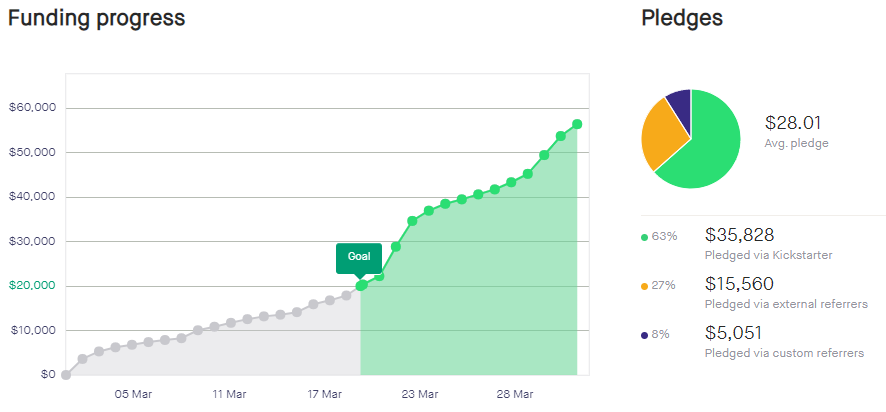Uncategorized
Crowdfunding Pitfalls You Aren’t Thinking About
You’ve got an amazing idea for a product. It’s amazing, and you can’t wait to see in the hands of other people who are going to love it. But despite an amazing idea and a willingness to make it happen, you lack one key component in making that idea a reality: money.
In the days of yore, if you didn’t have funds at your disposal, and you didn’t know how to get big-time investors on board with your idea, you were out of luck. Your big idea would stay locked in your head, never to see the light of day. You’d lay on your deathbead wondering what life would have been like if you could have made that thing, if only you had been the child of a well-connected hedge fund manager.
But now, thanks to crowdfunding platforms like Kickstarter and Indiegogo, regular Joes like you and I can raise enough capital to get turn our big ideas into big realities. It’s as easy as signing up on a website and pitching your idea to the masses!
However, there are a lot more pitfalls on the road to success than you might realize at the outset. Read on to see what we here at Lunch Break Heroes experienced during our first Kickstarter campaign, and what you need to be aware of.
Our Kickstarter campaign
In the winter of 2021, I launched a Kickstarter campaign to create a product that would help people tell stories during their tabletop roleplaying games. I had the idea of “Dungeons & Dragons meets Cards Against Humanity.” This idea blossomed into a deck of 200 cards in a beautiful box called The Deck of Many Quests. The original funding goal of the campaign was $20,000. Over the course of a month, it raised $56,439.

Two weeks after the campaign ended, the funds (minus fees) landed in my bank account. Needless to say, I was very pleased.
It was at that point that the real work began, and so did my crash course in turning an idea into a reality. But the lessons started earlier than this.
Pitfall One: It will cost more than you think
When I began researching manufacturers for The Deck of Many Quests, I had zero experience in sourcing and manufacturing a physical product. I knew that the deck would contain 200 cards—quite a few as decks of cards go—so I figured I would start by finding a similarly-sized product and see who its manufacturer was. This led me back to one of my core inspirations: Cards Against Humanity.
A quick Google search yielded that Cards Against Humanity was originally manufactured by Ad Magic. This was enough for me to get in touch with them and get a quote for a thousand copies, which totaled about $9,400. This price included manufacturing, product testing, and freight from China. The freight was the expensive part.
Chances are, a fair amount of time will elapse between the day you get that first quote from your manufacturer and the day you place your order. During that time, it’s likely (read: inevitable) that prices will rise—especially for freight.
If you think one month in a studio apartment in the city is expensive, try two weeks in a shipping container across the ocean. Yeesh.
But manufacturing and freight aren’t your only costs. Unless you’re a business owner, artist, marketing professional, and big-time influencer, you’re going to have other costs.
- Need a logo or artwork? Hire an artist.
- Need to use software you aren’t an expert in, such as CAD, desktop publishing, etc.? Hire a consultant.
- Need advice on getting the word out? Consult with a marketer.
- Need to get your product in front of an audience? Pay an influencer to pitch it to their audience.
All of these costs will come up before you raise a single penny through crowdfunding. Which can be discouraging, as it feels like a rehash of the old situation of “you need to have money to make money.” But compared to manufacturing and freight, the costs listed above are small. If you have the time and willingness to learn, you can pick up new skills and do some of this yourself. Otherwise, it’ll cost you. But trust me, your investments in these areas can have high returns later on.
Pitfall Two: Improper marketing will break you
Marketing will make or break your project. A mediocre crowdfunding project with a great marketing plan will almost always outperform an amazing project that has a crappy plan, or no plan at all. Simply put, if no one knows about your product, no one will fund it.
While you are probably not a marketing expert, it’s vital that you don’t ignore this part of your product’s journey from conception to reality. There’s a reason companies spend massive amounts of money on commercials and other forms of advertisement: they work.
The marketing plan behind your crowdfunding campaign should be laid out months in advance of your campaign’s launch date. You should know what messages are going out, to which audiences, through which channels, and when. Additionally, each one of those marketing message’s success should be measurable, so you know what is performing and what isn’t.
There are a myriad of ways to get the word out about your project. I’ll cover just a few here.
Pay-Per-Click (PPC) advertisements on platforms such as Twitter, Facebook, and Google are one of the easiest to set up. However, PPC ads are a great way to lose a lot of money quickly. Without careful tuning of your target audience and keywords, advertising platforms can show your ads to people who have no interest in what you’re trying to sell. Additionally, pointing even the most interested of individuals to a poorly design landing page will prevent them from converting, draining your ad budget for nothing.
In addition to PPC ads, influencers across social media are often happy to pitch your product—for a fee, that is. Costs vary depending on audience size, but the results can be tremendous if there’s a significant overlap between the influencer’s audience and the target audience of your product. Advertising in this way is more expensive up-front than PPC ads, but the bright side is that your product’s ad spot may be seen by audiences for years to come. Whereas those ads in people’s Facebook feeds disappear as soon as you turn the campaign off, a video on YouTube exists until the creator decides to remove it.
For The Deck of Many Quests, however, the most effective marketing channel were industry news websites. One article on Dicebreaker was responsible for 4.77% of our total funding. While that’s not a large percentage, the traffic and pledges their article brought in was enough to signal Kickstarter’s algorithm to put our project on the front page, thus creating a positive feedback loop, resulting in a massive $14,000 jump in funding over the course of three days.

Pitfall Three: Marketing needs to continue after launch
As tempting as it is, don’t launch your entire marketing campaign on day one. If potential backers see your product in their feeds for a single day, and never again, you lose your opportunity to convert them into paying customers. Many people will need to be exposed to your product multiple times in order to convert. To that end, your marketing campaign should involve multiple stages that engage potential customers across various platforms over a period of time.
While day one should consist of your “big guns,” your efforts to spread the word about your product should continue throughout the campaign’s lifetime. And if you plan to accept late pledges, they should continue well beyond.
Pitfall Four: Poorly designed art will make people ignore you
For the most part, creators on crowdfunding websites are small business owners with small operations and even smaller budgets. Many of them are undertaking this journey for the very first time. And pretty much everyone who backs a project on a crowdfunding website knows and accepts the fact that they’re giving money to amateur product producers. But despite the acceptance of the amateur backgrounds of many crowdfunding creators, there is very little tolerance for amateur artwork.
They always tell you not to judge a book by its cover, but that’s exactly what everyone does. For both books and crowdfunding campaigns.
The first exposure many people will get to your product is a single small image on a crowdfunding platform: your cover image. This image will be showcased right alongside other similar products, and as such it must be able to stand out. Not only that, but it must also instill within the backers’ minds a sense of confidence in your abilities as a product creator. To that end, shoddy crayon doodles will simply not do.
If you aren’t an artist, then this is where you should be hiring one.
Standing out on the crowdfunding platform is of paramount importance. 63% of the funds raised for The Deck of Many Quests came through the Kickstarter platform itself, and I’m sure that holds fairly true for most other campaigns. This is due in large part because the audience that is browsing around the platform is already motivated to buy—they’re on a crowdfunding website for the express purpose of backing projects. All you need to do is convince them that yours is the one to back.
However, the need for good artwork goes beyond the cover image. Everything on your campaign page should be well designed and eye-catching, to say nothing of any artwork that may be featured directly on your product! It simply won’t do to hook people in with a compelling cover image, and have them be underwhelmed by what they find on your details page.
Pitfall Five: You should have as much of your product finished as possible
Imagine this: you create a crowdfunding campaign for a book that you want to create. It could be a novel, or a zine, or a 300-page hardcover for your own tabletop RPG system. Whatever.
You set up your campaign. You create marketing materials. You get the word out. People are signing up on your watch page. The HYPE METER is off the charts! Pledges begin to pour in. Hundreds. Thousands. Tens of thousands. Suddenly, you’re at six figures!
A few weeks go by and your campaign closes. You raised more money than you ever thought you could. And pretty soon you’ll need to start shipping your book off to the backers.
Only… It’s not done yet. Not even by half. You had a few chapters written out; just enough for the campaign’s content teaser, but nothing more. Now suddenly you’re on the hook for an entire book, and your backers are expecting to receive what they pay for. Your stomach begins to sink under the weight of looming deadlines.
Does that sound like fun? It’s not.
Don’t go into a crowdfunding campaign with less than half of your product. If you’re publishing a book, have the majority of it written. Better yet, have all of it written. If not for the sake of your backers, then for the sake of your own sanity and nerves. Avoid putting a ridiculous amount of work on your shoulders on top of the normal stresses of running and fulfilling a crowdfunding campaign.
That’s hardly all
Those are just five pitfalls, but there are plenty more that you need to watch out for. Be on the lookout for part 2 of this series!

